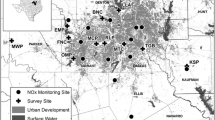Abstract
Invasions in urban settings have been understudied in terms of how invasions are impacted by uniquely urban stressors, such as streetlights. Plant physiology and phenology are impacted by artificial light at night (ALAN), but no studies have yet examined if light pollution differentially affects native versus invasive plant species. We tested the hypothesis that ALAN affects plant traits important to plant fitness and susceptibility to herbivory and whether they differ between invasive versus native grass species. We found that aboveground production of invasive cheatgrass was >5 × greater under ALAN than any other species in any treatment, and ALAN also altered plant traits important to herbivory. This suggests that ALAN may influence the outcomes of interspecific interactions. As urbanization increases, its role in invasion biology becomes more important, especially when an urban disturbance such as ALAN benefits the growth of invasive species.

Similar content being viewed by others
Data availability
Data are archived at Zenodo: https://doi.org/10.5281/zenodo.5676470.
References
Bennie J, Davies TW, Cruse D, Gaston KJ (2016) Ecological effects of artificial light at night on wild plants. J Ecol 104:611–620
Briggs WR (2006) Physiology of Plant Responses to Artificial Lighting. In: Rich C, Longcore T (eds) Ecological Consequences of Artificial Night Lighting. Island Press, Washington, DC, pp 389–411
Cavin JS, Kull CA (2017) Invasion goes to town: from distain to sympathy. Biol Invasions 19:3471–3487
Feeny P (1970) Seasonal changes in oak leaf tannins and nutrients as a cause of spring feeding by winter moth caterpillars. Ecology 51:565–581
Grenis K, Murphy SM (2019) Direct and indirect effects of light pollution on the performance of an herbivorous insect. Insect Sci 26:770–776
Lozon JD, MacIsaac HJ (1997) Biological invasions: are they dependent on disturbance? Environ Rev 5:131–144
Massetti L (2018) Assessing the impact of street lighting on Platanus x acerifolia phenology. Urban Forestry Urban Greening 34:71–77
Murphy SM, Wimp GM, Lewis D, Denno RF (2012) Nutrient presses and pulses differentially impact plants, herbivores, detritivores and their natural enemies. PLoS ONE 7:e43929
Murphy SM, Vyas DK, Hoffman JL, Jenck CS, Washburn BA, Hunnicutt KE, Davidson A, Andersen JM, Bennet RK, Gifford A, Herrera M, Lawler B, Lorman S, Peacock V, Walker L, Watkins E, Wilkinson L, Williams Z, Tinghitella RM (2021) Streetlights positively affect the presence of an invasive grass species. Ecol Evol 11(15): 10320–10326
Price PW, Denno RF, Eubanks MD, Finke DL, Kaplan I (2011) Insect ecology: behavior populations and communities. Cambridge University Press
Speißer B, van Kleunen LY (2020) Biomass responses of widely and less-widely naturalized alien plants to artificial light at night. J Ecol 109:1819–1827
Xu C, Wang H-J, Yu Q, Wang H-Z, Liang X-M, Liu M, Jeppesen E (2019) Effects of artificial LED light on the growth of three submerged macrophyte species during the low-growth winter season: implications for macrophyte restoration in small eutrophic lakes. Water 11:1512
Acknowledgements
We thank M. Berge, G. Connor, C. Hallagan, C. Harris, B. Babar, E. Barnes, G. Connor, S. DeSilva, C. Hallagan, S. Gosnell, S. Kraft, M. Mayeda, S. Neuder, G. Sommerville, and S. Winsett for lab help and C. Durso for statistical advice. We thank C. Nufio and the University of Denver’s Organismal Biology Group (DUEEB) for helpful comments on previous drafts.
Funding
Funding for this project was awarded to S. M. Murphy from the University of Denver.
Author information
Authors and Affiliations
Contributions
SMM and KG conceived of the project and collected the data; DKV analyzed the data. All authors wrote, revised, and approved the final version of the manuscript.
Corresponding author
Ethics declarations
Conflict of interest
The authors declare that they have no conflict of interest.
Additional information
Publisher’s Note
Springer Nature remains neutral with regard to jurisdictional claims in published maps and institutional affiliations.
Electronic supplementary material
Below is the link to the electronic supplementary material.
Rights and permissions
About this article
Cite this article
Murphy, S.M., Vyas, D.K., Sher, A.A. et al. Light pollution affects invasive and native plant traits important to plant competition and herbivorous insects. Biol Invasions 24, 599–602 (2022). https://doi.org/10.1007/s10530-021-02670-w
Received:
Accepted:
Published:
Issue Date:
DOI: https://doi.org/10.1007/s10530-021-02670-w




